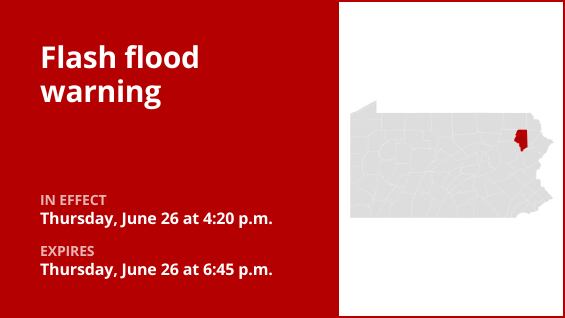The National Weather Service issued a revised flash flood warning for Lackawanna County on Thursday at 4:20 p.m., which is in force until 6:45 p.m.
“Doppler radar showed thunderstorms causing heavy rain throughout the advised area at 4:20 p.m. It has rained one and a half to three inches. According to the weather service, flash flooding is either already occurring or is predicted to start soon. “Multiple instances of roadway flooding have been reported across Dunmore and Scranton.”
Scranton, Dunmore, Dickson City, Olyphant, Clarks Summit, Clarks Green, Elmhurst, Mount Cobb, Taylor, Throop, Glenburn, and West Scranton are among the places affected by the warning.
“Flash flooding of small creeks and streams, urban areas, highways, streets and underpasses as well as other poor drainage and low-lying areas,” states the meteorological agency. “When you come across flooded roads, turn around to avoid drowning. The majority of flood fatalities involve automobiles.
Understanding the differences between advisories, watches, and warnings
-
Flash flood warning: Take action!
When a flash flood is either approaching or has already occurred, a warning is given. Moving to higher ground right away is essential in places that are prone to flooding. A flash flood is a quick, intense flood that can form in a matter of minutes to hours and even occur in places that aren’t currently receiving any rain.
-
Flood warning: Take action!
When flooding is about to occur or has already started, a flood warning is issued.
-
Flood advisory: Be aware:
When flooding is not predicted to become severe enough to warrant a warning, a flood advisory is issued. However, it still has the potential to be extremely inconvenient and, if careless, to result in circumstances that endanger life and/or property.
-
Flood watch: Be prepared:
When the weather is conducive to flooding, a flood watch is issued. Flooding is not guaranteed, but it is a possibility.
Staying safe during a flood: Recommendations from the weather service
Floods can be a serious hazard, particularly if you live in a flood-prone location or camp in a low-lying area. The weather service provides crucial flood protection instructions to protect you:
Go to a higher location:
Moving to higher ground should be your first course of action if you’re camping in a low-lying location or in an area that is prone to flooding.
Respect evacuation directives:
Respond quickly to any evacuation orders issued by local authorities. Secure your home by locking it before you leave.
Cut off appliances and utilities:
Disconnect your appliances and utilities if you have the time. By doing this, the possibility of electrical risks during floods is decreased.
Steer clear of waterlogged regions and basements:
Avoid basements or rooms with electrical outlets or cords submerged in water. This lessens the chance of electrical mishaps.
Quickly leave for your safety:
Evacuate right away if you see sparks or hear popping, crackling, buzzing, or snapping sounds. Steer clear of any water that might be electrically charged.
Avoid going on foot in floodwaters:
Never try to cross flooding on foot. Six inches of quickly flowing water can knock you off your feet with force.
When stuck, look for higher ground:
If you find yourself caught by flowing water, get to the highest position you can and call 911 to get help.
Flooding may occur during periods of intense precipitation, particularly in low-lying and flood-prone locations. Even if the water doesn’t seem deep, you should never drive across it. The weather service claims that most cars can be washed away with just 12 inches of surging water. Put your safety first by being aware and ready.
Rainy roadways ahead: Essential safety tips for heavy rain
There is a greater chance of floods and dangerous roadways when it rains a lot. The weather service has provided the following advice to help you keep safe during downpours:
Watch out for flooding rivers:
When it rains a lot, stay clear from parking or strolling near culverts or drainage ditches since the swift-moving water could carry you away.
Keep your distances from other vehicles safe:
In heavy rain, the two-second rule of following distance is your friend. To guarantee safe spacing under unfavorable circumstances, increase it to four seconds.
Reduce your speed and exercise caution:
It’s crucial to slow down on wet roads. To avoid sliding, reduce the accelerator gradually and don’t brake suddenly.
Pick your lane carefully:
Water tends to pool in the outside lanes, so stick to the central ones.
Visibility is important.
As rain-spattered windows make it more difficult to see other vehicles, turn on your headlights and pay attention to those in blind spots and behind you.
Be cautious on slick roads:
Because of a combination of rain, oil, and grime, roadways are at their slickest during the first 30 minutes of precipitation. Be especially careful during this time.
Stay a safe distance away from big cars:
Tire spray from big vehicles and buses can make it harder to see. Pass them quickly and safely, and refrain from tailgating.
Be mindful of your wipers:
-
Overloaded wiper blades can hinder visibility. If rain severely impairs your vision, pull over and wait for conditions to improve. Seek refuge at rest areas or sheltered spots.
-
When stopping by the roadside is your only option, position your vehicle as far off the road as possible, ideally beyond guardrails. Keep your headlights on and activate emergency flashers to alert other drivers of your position.
You may greatly lower dangers and protect your health when it rains a lot by adhering to these safety precautions. To ensure a safe and sound voyage, keep yourself updated on weather conditions and follow local authorities’ instructions.
United Robots offers a service called Advance Local Weather Alerts that gathers the most recent information from the National Weather Service using machine learning.






